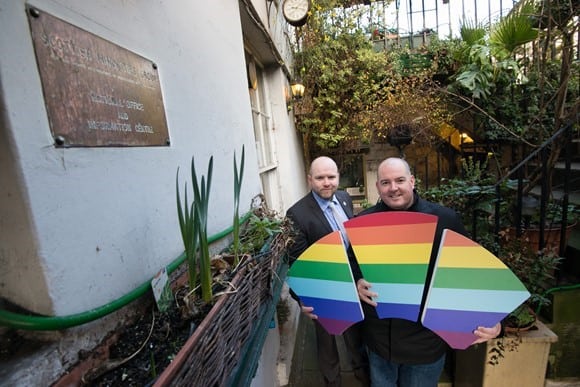Historic Environment Scotland (HES) are seeking help from the public to commemorate lesbian, gay, bisexual and transgender figures from Scotland’s past as the country marks LGBT History Month.
HES are extending nominations for the national Commemorative Plaque scheme until 28th February, urging a particular focus on LGBT individuals whose life and achievements have made a difference to Scotland and its people.
Since the Commemorative Plaque scheme was launched in 2012, 55 plaques have been awarded to significant contributors to life in Scotland – from famous inventors like James Watt and John Logie Baird, to artists such as Joan Eardley and prominent sportspeople such as golfer Willie Park Snr.
HES are now encouraging the public to identify buildings with a specific connection to leading LGBT figures from Scotland’s history.
Martin Ross, Grants Development Manager at HES, said: “I’m pleased to announce we will be extending nominations for the national Commemorative Plaque scheme until the end of February.
“Traditional methods of commemoration, such as plaques, have not always reflected the diversity of Scotland’s population or recognised the contribution of minority groups. We’re asking the public to help us rectify this as we celebrate LGBT History Month, by shining a spotlight on Scotland’s rich and diverse history and recognising the LGBT individuals who have played a significant role in our country’s story.”
The extension to the nomination period was announced at 58 Broughton Street, Edinburgh, by representatives from the Equality Network and Edinburgh’s LGBT community. Broughton Street, alongside nearby Picardy Place, Greenside Place and Barony Street remain the historic centre of Edinburgh’s LGBT community. 58 Broughton Street, the original home of the Scottish Minorities Group Centre, is a listed building and sits within the New Town conservation area and Edinburgh World Heritage Site.
Scott Cuthbertson, Development Manager at Equality Network, said: “One of the reasons we have an LGBT History Month is to explore the hidden histories of LGBT people.
“Past criminalisation and stigma often meant LGBT people lived in secrecy and their achievements went unacknowledged. We welcome this initiative by Historic Environment Scotland in extending the nominations period for the Commemorative Plaque scheme.
“We hope people from across Scotland put their thinking caps on and nominate LGBT people and places which may have until now gone unrecognised.”
Past nominees for the Plaque scheme have included artists, scientists, inventors, philanthropists, actors, engineers, explorers, suffragettes, poets, politicians, writers, architects, and even a potato farmer. The only criteria HES insists upon is that the person nominated has been deceased for at least twenty years, and that the building where the plaque is to be erected has a close connection to that person.
This year’s nominations will now close on 28th February 2018. An independent panel will then consider all the nominations and select the successful applicants, which will be announced in Spring 2018.
To find out more about the Commemorative Plaque scheme, and to submit a nomination, visit http://historicenvironment.scot/commemorative-plaque-scheme.
LGBT History Month takes place in February each year. At its heart, it’s an opportunity to celebrate LGBT life and culture and to recognise the achievements of LGBT people and communities. For more information, visit http://www.lgbthistory.org.uk/






